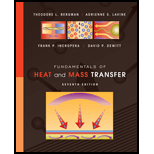
An ocean thermal energy conversion system is beingproposed for electric power generation. Such a systemis based on the standard power cycle for which theworking fluid is evaporated, passed through a turbine, and subsequently condensed. The system is to be used in very special locations for which the oceanic watertemperature near the surface is approximately
Want to see the full answer?
Check out a sample textbook solution
Chapter 11 Solutions
Fundamentals of Heat and Mass Transfer
Additional Engineering Textbook Solutions
Fluid Mechanics Fundamentals And Applications
Vector Mechanics for Engineers: Statics
Engineering Mechanics: Statics
Heat and Mass Transfer: Fundamentals and Applications
Mechanics of Materials, 7th Edition
Machine Elements in Mechanical Design (6th Edition) (What's New in Trades & Technology)
- Explain why a waterless, earth-coupled, closed-loop geo-thermal heat pump system is more efficient than a conventional closed-loop geothermal heat pump system.arrow_forwardWelded ______sealed compressors are normally used in household refrigerators.arrow_forwardA Refrigerant 22 vapour compression system meant for food freezing oper- ates at 40°C condensing temperature and –35°C evaporating temperature. Its compressor is capable of pumping 30 L/s of vapour at suction. (a) Calculate the COP of the system and its refrigerating capacity. (b) If a regenerative heat exchanger is installed which allows suction vapour to be heated by 30°C with liquid from the condenser at 40°C to be cooled correspondingly, what is the new COP and refrigerating capacity?arrow_forward
- A refrigeration system operates on an ideal vapor compression using R-12 with an evaporator temperature of -30 C and a condenser exit temperature of 49.30C and requires 74.6 kW motor to drive the compressor. What is the capacity of the refrigerator in tons of refrigeration? Enthalpy at the condenser ,entrance = 382KJ/Kg, exit = 248.15KJ/Kg, at evaporator entrance= 248.15kJ/kg, exit =338.14kJ/kg.arrow_forwardA surface condenser serving a 50,000-kW steam turbo-generator unit receives exhaust steam at the rate of 196,000 kg/hr. Vacuum in condenser is 702 mmHg. Sea water SG=1.03 and Cp=0.93 Btu/lb-F is used for cooling enters at 29.5C and leaves at 37.5C. From the steam condenser design, manufacturer consider 950 Btu/lb of steam condensed as heat given up cooling water. Calculate the required quantity of cooling water in m3/s.arrow_forwardA refrigeration system using refrigerant 12 is to have a refrigerating capacity of 80 kW. The cycle is a standard vapor-compression cycle in which the evaporating temperature is -15°C and the condensing temperature 30°C. Determine the volume flow of refrigerant measured in liters per second at the inlet to the compressor.arrow_forward
- Air source heat pumps are generally used to heat houses in Urla during winter. They typically have two heat exchangers. The one found in the exterior unit has a coil of tubing filled with a refrigerant. Since the refrigerant liquid is cooler than the surrounding air, heat is drawn into the coil from the surrounding. This warms the refrigerant so that it transitions to a gas. In this form, the refrigerant travels into the house to the heat pump's interior unit. Naturally, the heat is transferred from the refrigerant in the interior unit coil to the house. Consider a house equipped with an air source heat pump in a winter day at an outside temperature of 7 °C. The average room temperature inside the house is 22°C. The house is not well-insulated and therefore loses heat at a rate of 45,000 kJ/h. If the refrigerant temperature decreases by 5°C while it flows through the heat pump's interior heat exchanger unit, calculate the minimum flow rate of the refrigerant in kg/s required to keep…arrow_forwardA vapor compression refrigeration cycle operates at steady flow conditions with 0.25kg/s or R-134a. The table below shows some of the operating parameters andproperties for the refrigerant. The compressor is refrigerated, and the condenser is alsocooled with water. The compressor receives shaft power equivalent to 7.5 hp.Neglecting changes in kinetic and potential energy changes and any heat loss betweendevices, please answer the following.a. Complete the table below and sketch the cycle processes on a T-s diagram.When completing the table please use the same number of decimal places as inthe tables.b. Determine the cooling capacity of the refrigeration unit, in Tons (1 refrigerationTon = 211 kJ/min).c. Compute the COP.d. Determine the volume flow rate of refrigerant entering the condenser in L/min.e. Determine the mass flow rate of cooling water passing through the condenser.f. Determine the heat transfer rate from the compressor.g. Compute the rate of entropy generation in the…arrow_forwardA vapor compression refrigeration cycle operates at steady flow conditions with 0.25kg/s or R-134a. The table below shows some of the operating parameters andproperties for the refrigerant. The compressor is refrigerated, and the condenser is alsocooled with water. The compressor receives shaft power equivalent to 7.5 hp.Neglecting changes in kinetic and potential energy changes and any heat loss betweendevices, please answer the following. I understand how to fill the values but I get lost after that, need some help.arrow_forward
 Refrigeration and Air Conditioning Technology (Mi...Mechanical EngineeringISBN:9781305578296Author:John Tomczyk, Eugene Silberstein, Bill Whitman, Bill JohnsonPublisher:Cengage Learning
Refrigeration and Air Conditioning Technology (Mi...Mechanical EngineeringISBN:9781305578296Author:John Tomczyk, Eugene Silberstein, Bill Whitman, Bill JohnsonPublisher:Cengage Learning
